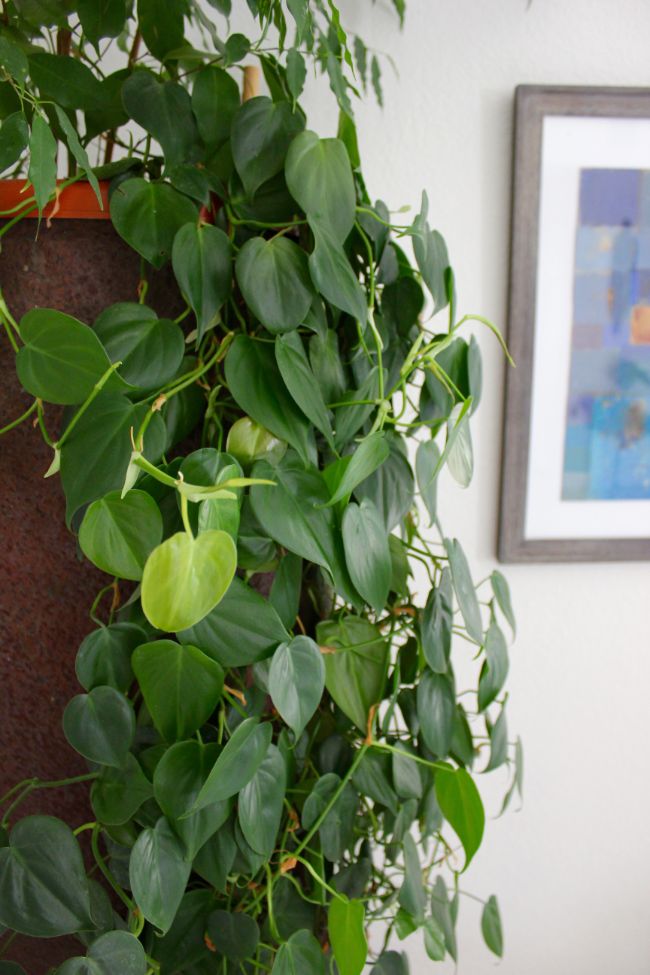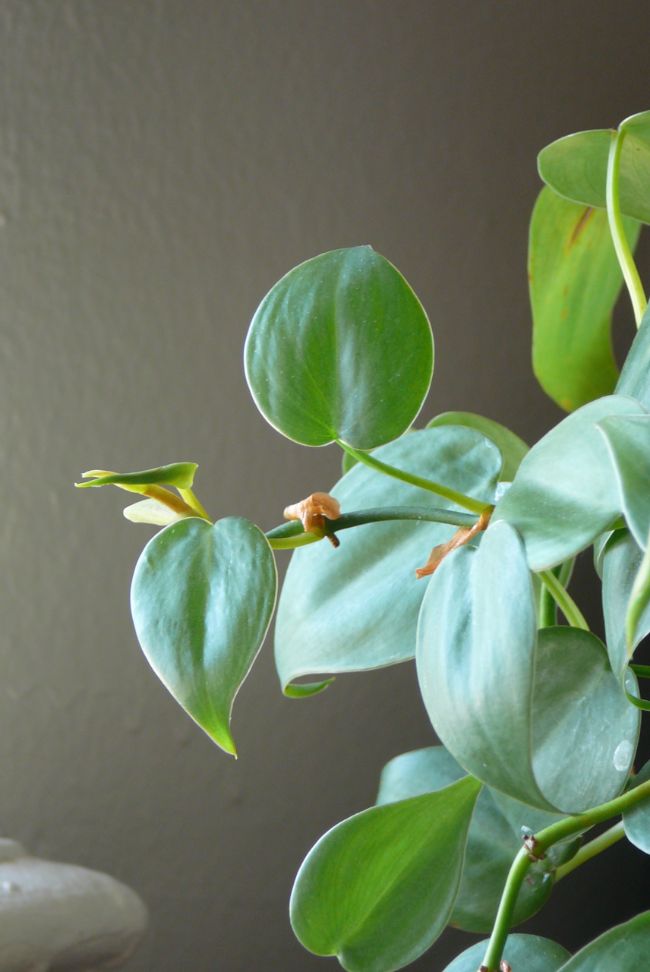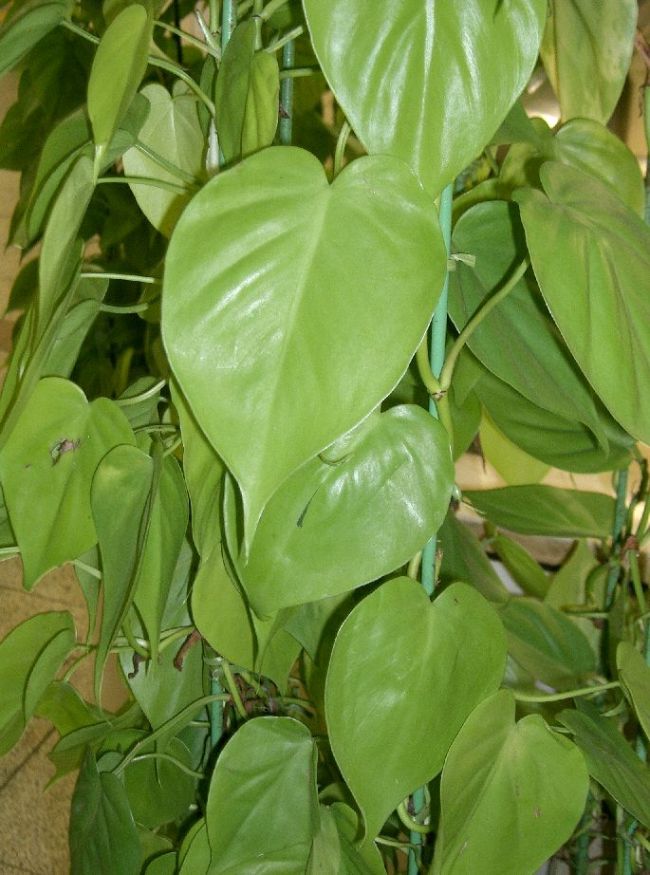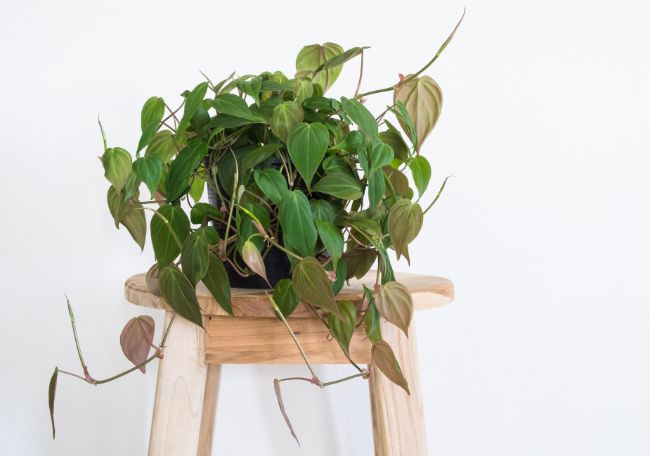Heartleaf philodendron (Philodendron hederaceum) is among the most common houseplants because of its easy to grow nature and lower light requirements. If you’ve struggled growing houseplants in the past because of poor natural sunlight in your home, or the tendency to neglect plants, you should try your hand at growing a heartleaf philodendron!
How to care for heartleaf philodendron: Provide bright, indirect sunlight, grow in well-draining soil and keep the soil slightly moist. Reduce watering during the fall and winter, fertilize lightly every month, and pinch back the stems to create a fuller, bushy plant.
If you’re interested in learning more about the easy to grow heartleaf philodendron, read on. The following information covers all of the different aspects of caring for this beautiful houseplant.
Heartleaf Philodendron Care Summary
- Scientific Name: Philodendron hederaceum (synonym Philodendron scandens)
- Common Name: Heartleaf philodendron
- Origin: Central America and the Caribbean
- Light Requirements: Bright, indirect light, but will tolerate lower light levels very well.
- Watering: Keep the potting soil lightly moist during the growing season. Reduce watering in autumn and winter. Consider using filtered water or rainwater.
- Soil: Choose a well draining potting mix. Most general houseplant potting mixes are suitable.
- Temperature: 70°F-80ºF (24C°-27ºC) for optimal growth. Avoid temperatures lower than 55ºF (13ºC).
- Fertilizer: Balanced, water-soluble fertilizer applied every 3-4 weeks when the plant is actively growing. I use this one.
- Humidity: Medium to high humidity, >40%.
- Flowering: Rarely indoors, and requires a mature plant of >15 years old.
- Pruning: Prune or pinch back stems to maintain bushy growth or to control size.
- Propagation: Stem cuttings can be easily propagated in water or soil.
- Re-Potting: Every 2-3 years to refresh the potting mix and avoid the plant becoming too root bound.
- Diseases and Pests: Root rot and pests are more likely in an overwatered plant. Aphids, scale, spider mites, fungus gnats, and mealybugs.
- Toxicity: Toxic if ingested.
- Where To Buy: Buy Heartleaf Philodendron online at Etsy (I buy most of my houseplants from Etsy).
Overview Of Heartleaf Philodendron (Philodendron Hederaceum)
There are over 400 different species of philodendrons, covering a variety of growing methods, leaf shapes, etc. For simplicity’s sake, these different species can be classified as either climbers or non-climbers.
- Climbers are well suited for homes and indoor office spaces because plants are smaller in stature.
- Non-climbers are capable of growing into immense plants with large, deeply-lobed leaves; they are more suited for public spaces and are often found in shopping malls, museums, and similar settings.
Of the climbing philodendrons, the most common and one of the easiest known houseplants to grow is the heartleaf philodendron, or Philodendron scandens. Originating from the rainforests of South America it is also known as the sweetheart philodendron.
Characteristics Of The Heartleaf Philodendron
- Thin stems grow up to 4 to 6 feet in length to create trailing vines.
- Dark green heart-shaped leaves, grow up to 2-4 inches in length.
- It can also be trained to climb up a trellis or other support.

Heartleaf Philodendron Care Requirements
Given their tropical nature, Philodendron scandens is typically grown indoors where the temperatures are steadily warm all year round, but heartleaf philodendrons can be grown outside in certain growing zones. USDA Hardiness Zones 10B through 11 are warm enough to grow the plants outside to create a lush, dark-green ground cover in shaded areas.
When growing plants in your home, provide the following growing conditions to promote strong, healthy plants.
Light Requirements
Heartleaf philodendrons are popular in homes because they have low light requirements compared to many other types of houseplants. They originate from the rainforest floors of South America, where there is little direct light beneath the forest canopy.
Place your philodendron where it can receive bright, indirect light for a minimum of three to four hours a day. Plants will also tolerate a range of lighting conditions from diffused light to almost full shade, and even thrive when grown indoors under fluorescent lights.
Avoid putting your plants where they can receive direct sunlight as this can burn the leaves.
Just note that the lower the light conditions, the slower the plant growth. Small leaves or long spaces between leaves show that the plant is not getting enough light.
Temperature
One of the reasons heartleaf philodendrons thrive indoors is because they prefer the same temperature range(s) as we humans do. For best growth keep them where temperatures are between 70°F-80ºF (24C°-27ºC) during the day and above 55º F (13ºC) at night.
Avoid placing your plants where they are exposed to drafts coming from leaky windows, or register vents blowing heat in the winter and cool air in the summertime.
Humidity
Sweetheart philodendrons will thrive in homes with higher humidity, and do well in bathrooms if they can receive enough sunlight. The warm, moist air is reminiscent of their rainforest beginnings. Higher relative humidity levels result in larger, showier leaves.
While philodendrons prefer high humidity, they are capable of tolerating the low humidity levels of a typical household. Watch for brown leaf tips though, as that is a sign the air is too dry.
If they begin to show brown tips, you can increase the humidity level by misting the plants with water a couple of times a week, grouping plants together, or setting your heartleaf in a tray containing pebbles and water. Read more about the best ways to increase humidity for your houseplants here.
Heartleaf Philodendron Soil Requirements
Heartleaf philodendrons prefer a soil that drains quickly and provides good aeration to the roots. Due to this most “all-purpose” commercial potting soils are suitable. Avoid anything specifically formulated for a given type of plant such as acid-loving plants or succulents.
Commercial potting soils are actually a “soilless” mix of peat moss, coconut coir, pine bark, and either perlite or vermiculite. Avoid using straight coconut coir or sphagnum peat moss in your containers; they retain too much water. To improve the drainage rate of the potting soil you can add extra perlite.
Watering
During the active growing season in the spring and summer keep the potting soil slightly moist, although not soggy, at all times.
During the winter when growth is slower, allow the top part of potting soil to dry out completely before watering. Yellow leaves indicate over-watering and brown leaves mean the plant needs more water.
Water with tepid water, best if it is allowed to sit for a couple of days to allow the chlorine in treated water to dissipate.
Read my article about assessing whether your houseplants need water. This is one of the most important skills you need to learn to keep your indoor plants thriving.

How To Fertilize Heartleaf Philodendron
Fertilize lightly every 3-4 weeks during the active growing season. Look for a water-soluble or liquid all-purpose plant food and mix it at the recommended dosage on the label or slightly more diluted. This is the houseplant fertilizer I use for a lot of my indoor plants.
Flowering
It is very rare for heartleaf philodendrons to bloom indoors and only occurs when the plant is fully mature at fifteen to sixteen years old. Flowering is solely for reproduction and typically happens between May and July. Each plant will have 2 to 3 blooms that open up over the blooming period, staying open for only a couple of days.
When it is time to flower the plant will produce a spathe that is a green color and oval in shape. Inside the spathe is a long, white spadix containing both female and male fertile flowers.
Pruning
Pinch back the stems of your heartleaf to keep them from getting too leggy or stringy. This triggers growth from growing points at the nodes on the stem, creating a fuller, bushier plant.
You can pinch the stems back at any time but it’s best to do it when the plant is actively growing during the warmer months. When you pinch them, make sure to create a clean cut directly after a leaf node using either your fingernails or a sharp pair of clean scissors.
How To Propagate Heartleaf Philodendron
Another really great aspect of growing heartleaf philodendrons is how easy they are to start new plants from. To help plants climb up trees in the rainforest, they develop aerial roots that form from the nodes on the stems. Nodes contain cells that will develop new roots. This makes stem cuttings incredibly easy to propagate.
In spring or early summer remove a 3 to 4-inch long stem tip cutting that has at least 3 leaves attached to the end piece. Cut just below a leaf node where a leaf is attached to the stem. You can then place the cutting in a jar or glass with clean water or immediately put it in a small container with moist potting soil.
Re-Potting
Your heartleaf philodendron should be repotted every 2-3 years to provide it with fresh potting soil and ensure the container is big enough for the root system. A plant that is root-bound in a container will have slower growth.
An important note — when filling containers with growing media do not create a “drainage layer” in the bottom of the pot. For a long time, this was a highly recommended practice, taught to new gardeners. It’s been proven though that this practice is more detrimental than helpful.
As water moves down through the soil profile via gravity, it stops when it encounters this drainage layer created by rocks or small stones. Before the water percolates into the layer, the entire potting soil must fill with water rendering the layer problematic instead of beneficial.
Diseases And Pests
Diseases and pest problems in philodendrons are not common, although they do exist. One of the biggest culprits of both is overwatering so watering plants only when they need it will help prevent problems.
Monitor your plants frequently to catch problems early and treat them before damage is extensive.
Diseases
Thankfully, root rot is the only real disease problem that manifests in heartleaf philodendrons.
Root Rot
The most commonly seen problem with heartleaf philodendron is root rot, caused by overwatering, especially in the winter months. The roots then die back due to lack of oxygen or the overgrowth of a soil fungus. Soggy soils encourage the growth and multiplication of Pythium, Phytophthora, Rhizoctonia, or Fusarium fungi which spreads into the roots, infecting plants.
Healthy roots begin to turn brown and mushy as they perish, unable to take in nutrients needed for growth. As root rot progresses leaves turn yellow, wilt, or droop and then become mushy as well. Once symptoms are visible in the leaves the problem may be past the point of rectifying, endangering the entire plant.
The challenge with root rot is that it often goes unnoticed because it occurs beneath the soil surface and out of sight. In extreme cases when conditions are perfect, i.e. in pots without drainage holes, root rot can kill the whole plant within ten days.
If caught soon enough you can repot the plant, to try to save it. Remove as much of the infected soil as possible adding in fresh, clean potting soil. If root rot has spread significantly, dissect the plant, keeping only the healthy portions. If the whole base is affected, take stem cuttings from healthy foliage to propagate a new plant.
Insect Pests
Insect problems are going to be your biggest challenge with heartleaf philodendron plants, mainly if you have neighboring houseplants with aphids, spider mites, fungus gnats, mealybugs, or scale.
Aphids
Aphids are one of the most common insects affecting indoor plants. These tiny, pear-shaped insects attach themselves to the plant, sucking sap from the plant tissues, and then secreting “honeydew”. Symptoms appear as distorted foliage and leaf drop.
Remove aphids by wiping the plants with a clean, soft cloth or spraying the plants with a mild solution of water containing a few drops of dish soap.
Spider Mites
These tiny sucking pests are found on the undersides of leaves, wreaking havoc on indoor houseplants. Spider mites feed on the fluids found inside the leaves of heartleaf philodendron, piercing the waxy coating to access the internal fluids.
One of the biggest challenges with spider mites is their prolific nature; oftentimes a heavy infestation will occur, unnoticed, before plants begin to show physical symptoms of damage.
With an infestation of spider mites, leaves may be stippled with discoloration or turning yellow overall. Plants may also exhibit a fine, spider-like webbing between the leaves or at the base of the plant.
Fungus Gnats
Primarily considered a nuisance, fungus gnats are small, dark flies that somewhat resemble tiny mosquitos. They are associated with damp environments and emerge from houseplant soil.
While the damage they do to plants is most often minor the adults become an annoyance when they make their way into living areas of your home or congregate around windows.
Mealybugs
These pink, soft-bodied insects are covered with a white, waxy, almost cottony-like material. The cottony fluff protects them from moisture loss and excess heat. Mealybugs are usually found in colonies in somewhat protected areas of the philodendron such as where the leaves attach to the stems.
Mealybugs are similar to their relatives the soft scales but they lack the scale covering and retain legs throughout their life cycle allowing them to move around.
Symptoms show as stunted or deformed leaf growth, especially on new foliage as mealybugs inject a toxin into leaves when they feed on the plant’s fluid. They also excrete honeydew as they feed, encouraging the growth of sooty mold
Scale
Scale is a threat to most species of shade and fruit trees, ornamental shrubs, and houseplants. The pests pierce leaves, stems, branches, and tree trunks to feed on the sap within these plant tissues, damaging the plant overall.
There are two different types of scale insects that infest heartleaf philodendron: soft and armored scale. Both appear as little brown bumps on the leaves with the soft scale being more prevalent. Insect sizes range from ⅛ to ½ inch in length; color, shape, and texture vary amongst different species.
Soft scale insects do not possess a hard, protective coating so they generate either a thin, powdery, cotton-like or waxy layer over their bodies for protection. These layers cannot be separated from the insect body.
Armored scale, on the other hand, creates a hard shield-like layer from shed skins and wax to protect themselves from natural predators and chemical insecticides. This layer can be separated from the insect body and tightly adheres the scale to the plant forming a waterproof seal.
Besides the notorious leaf drop, plants infected with scale exhibit yellowing leaves. The yellow spots appear on the tops of the foliage while the insects suck sap and chlorophyll from the bottom. Leaves may wilt, become stunted, and you may see decreased vigor overall in the plant. To tell the difference in types of scale look for honeydew secretions; soft scale secretes a large amount of honeydew, the armored scale does not.
Read my article about how to get rid of houseplant bugs naturally for all the best ways to get rid of pests on your houseplants forever.
Is Heartleaf Philodendron Poisonous?
This is the one drawback to heartleaf philodendrons: they are toxic to pets and can trigger mild allergic reactions in people.
Chewing on plant leaves and stems can cause oral pain and discomfort, drooling, foaming at the mouth, vomiting, and moderate to severe swelling of the lips, tongue, oral cavity, and upper airway. People can experience minor skin discomfort if they get sap on their skin.
Keep plants up high where pets and small children can’t reach the leaves.
Common Problems And Questions

Can my heartleaf philodendron plant be moved outside?
Yes, your heartleaf philodendron can be moved outside, as long as the conditions are suitable. Do not set them in direct sunlight, instead set them under the shade canopy of a tree where they can get diffused light, and bring them in if the temperature drops to 60 or 65℉.
If plants are overwatered, is it possible to fix the problem?
The best way to correct overwatering is to repot the plant immediately to prevent root rot. During the repotting process gently remove some of the waterlogged soil from the root ball, replenishing it with fresh, new soil that has good drainage capabilities.
How do you clean dirt and dust from the leaves of a heartleaf philodendron?
There are numerous ways to clean dirt and dust from the leaves of a heartleaf philodendron. If the accumulation is minimal you can quickly use a feather duster to clean them. You can also use a clean, damp cloth to carefully wipe each leaf clean. If the plant is really dirty you can put it in the bathtub and rinse it off using lukewarm water from the showerhead, making sure they air dry completely before putting them back in their spot.
Read my article about cleaning indoor plants for all the detail and best methods for cleaning all your houseplants.
Why are my heartleaf philodendron leaves turning yellow?
Yellow leaves on a heartleaf philodendron almost always indicate overwatering. Allow the potting soil to dry out slightly between waterings to prevent the leaf yellowing.


